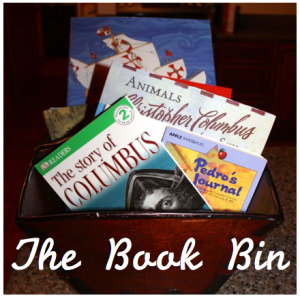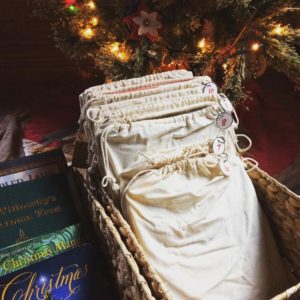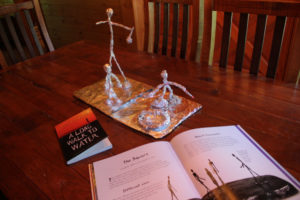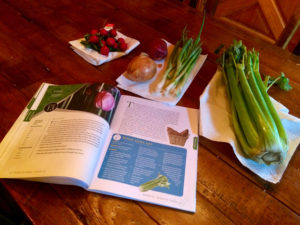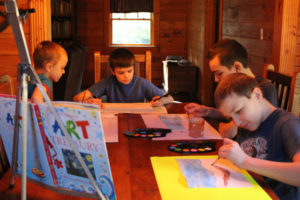Every year we receive this question, and it seems that especially this year it’s been tough making decisions regarding literature and curriculum. But how can that be? We graduated our oldest in May, so we should know what we’re doing by now. And yet… each of our children are so different, and in my heart, it becomes more and more imperative to customize the learning experience for our boys. Our children are not the same. So… things don’t look the same. God has a special calling for each of them, and we want to do what we can to hone gifts and callings while our children also earn the credits required by our state.
I love to set goals with my children, and I love learning with them. It’s one of the greatest pluses of homeschooling. But posts like this can be misinterpreted. So, before providing a sneak peek at our literature and curriculum selections, let’s revisit our top lessons learned from our first 10+ years of homeschooling.
- Seek first the kingdom of God. Loving God and fellow man (including siblings) takes precedence over everything else.
- Relationship is far more important than curriculum and lesson plans. Get to know your children and their interests. Seek opportunities to encourage them in those interests, but also hold them accountable to do their best in whatever they do.
- Young children operate best with short 15-minute lessons and plenty of time to explore nature and use their hands. (Boys especially struggle with sitting at a desk for long periods of time. We’ve completed our book work on the playground, the trampoline, the patio, sitting upside down in a chair…)
- Reading together provides an opportunity to build your family’s relationships through shared stories and discussion. During family read aloud time, it’s okay if children are using their hands (playing with LEGOs, coloring, etc.). In fact, we’ve found that it’s necessary.
- Give yourself and your children the grace of tapering into the school year, taking breaks when needed, and doing whatever needs to be done in the midst of your real, everyday life.
- Be prepared, but hold your plans and expectations loosely, for God may have a special unexpected purpose for your family to pursue.
- Focus on learning and character-building rather than grades and test scores (at least until middle or high school).
- Resist falling into the trap of comparison. Do what’s best for your family, regardless of what others say.
- Choose joy. Learning can be hard, but it’s also exciting and rewarding. If you’re filled with a sense of dread as you enter a new school year, it’s time to change what you’re doing.
- If you’re new to homeschooling, start simple. Reading, writing, and arithmetic. These are the foundational skills needed for learning anything. Add other things when you discover interests and giftings.
- Be confident but also recognize that plan doesn’t equal reality. As with starting anything new, it may be a rocky road at first. (Remember, mercy triumphs over judgment!) Pray for guidance, wisdom, and grace, and lay all your efforts at the feet of Jesus. It’s all for Him anyway!
As I share this, remember that first of all, it can look more foreboding on paper than in real life. Second, start simple and figure out what works well for your family. And last, this is simply to provide a peek at what we’ve chosen after reviewing a ton of different curriculum and books. Perhaps there’s a treasure here for your family to discover, too!
Literature Selections
Let me just confess this at the forefront. It actually hurts that I’m only planning for three students. I’m so excited that our oldest is headed into a new chapter of his life, but oh, my heart! I have literally wept as I’ve written lesson plans for the coming year. Looking back now, I’m even more grateful for all the memories homeschooling has afforded us. Thank you, Lord, for this beautiful gift!
Although our oldest has graduated, we still have a student at each level: elementary school, middle school, and high school, so let’s just start with literature selections. (You can just scroll to the level of interest and ignore the rest. You can also scroll down to see our family morning time, our curriculum choices at each level, and an example schedule.)
Family Read Alouds – World Cultures, World Religions, World Missions(Africa, Asia, and Americas)
We’ve studied history, religion, cultures, and geography through inspiring true stories of missionaries, and I can’t tell you how much these stories have impacted our lives!
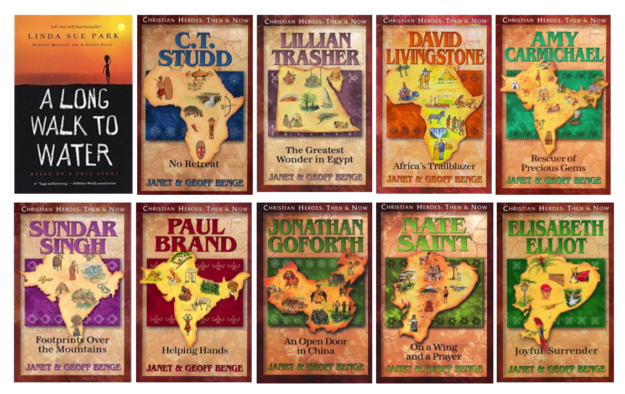
We’re repeating three of the stories we read three years ago while also reading a few new ones. Repeats include:
- A Long Walk to Water (Sudan).
- Lillian Trasher: The Greatest Wonder in Egypt (Egypt).
- Sundar Singh: Footprints over the Mountains (India/ Tibet).
Our new read-alouds include:
- C.T. Studd: No Retreat (Missionary to the Congo).
- David Livingstone: Africa’s Trailblazer (Missionary to Southern Africa).
- Amy Carmichael: Rescuer of Precious Gems (Missionary to India).
- Paul Brand: Helping Hands (Missionary to India).
- Jonathan Goforth: An Open Door in China (Missionary to China).
- Nate Saint: On a Wing and a Prayer (Missionary to Central & South America).
- Elisabeth Elliot: Joyful Surrender (Missionary to Ecuador).
Our family read-alouds are taken from our Mission: World Wonders and Mission: World Wonders Trip #2 plans. If you happen to be a family using Classical Conversations, the books above would be great to read during Cycle 1.
High School Literature Selections – Ancient History/Literature
Literature Selections for our high school student roughly follow Dave Raymond’s Antiquity (from our favorite high school history course).
Some of these are quick, 1-week reads; some will take up to 6 weeks to complete. Instead of using regular comprehension literature guides, our family’s literature discussions follow the Teaching the Classics Approach. (We highly recommend Teaching the Classics for parents to learn how to discuss literature with their children!) Our children will be filling out a story chart for each work of literature this year while also practicing the art of narration.
- Eternity in their Hearts by Don Richardson
- Paradise Lost by John Milton
- Tales of Ancient Egypt by Roger Lancelyn Green
- Cat of Bubastes by G.A. Henty
- Hittite Warrior by Joanne Williamson. This is a somewhat simple read for high school, but it includes such an interweaving of ancient civilizations that it helps to solidify the historical context and understanding of civilizations existing at the same time.
- Selections from The Iliad with Center for Lit Guide and Heroes of the City of Man. After reading a summary of the storyline of The Iliad (from Black Ships Before Troy) we will tackle parts of the Fagles translation using Heroes of the City of Man as a guide.
- Screwtape Letters by C.S. Lewis
- Selections from The Odyssey with Center for Lit Guide and Heroes of the City of Man. After reading a summary of the storyline of The Odyssey (from The Odyssey by Geraldine McCaughrean, we will tackle parts of the Fagles translation using Heroes of the City of Man as a guide.
- The Aeneid by Virgil and Heroes of the City of Man. (We may reference The Aeneid for Boys and Girls by Alfred Church.)
- The Young Carthaginian by G.A. Henty
- Julius Caesar by William Shakespeare
- The Man Born to be King by Dorothy Sayers
- Through Gates of Splendor or Shadow of the Almighty by Elisabeth Elliot
Middle School Literature Selections – Ancient through Renaissance
Our middle-schooler’s literature selections will correspond roughly to history assigned in Mission: World Wonders (which is Story of the World Volume 1 and Story of the World Volume 2).
In most cases, he will be spending 3 weeks on each book. (Black Ships Before Troy, Wanderings of Odysseus, and The White Stag are shorter. The Hobbit is longer.)
- The Golden Goblet by Eloise Jarvis McGraw
- Hittite Warrior by Joanne Williamson
- God King: A Story in the Days of King Hezekiah by Joanne Williamson
- Black Ships Before Troy by Rosemary Sutcliff
- The Wanderings of Odysseus by Rosemary Sutcliff
- The Bronze Bow by Elizabeth George Speare
- The White Stag by Kate Seredy
- King Arthur and his Knights of the Round Table by Roger Lancelyn Green
- A Single Shard by Linda Sue Park
- The Adventures of Robin Hood by Roger Lancelyn Green
- The Hobbit by J. R. R. Tolkien
- The King’s Fifth by Scott O’Dell
- Tales from Shakespeare by Tina Packer. To end the year, we just wanted a quick, simple summary of 10 of Shakespeare’s works which we’ll be exploring in greater detail in years to come. This book is a family favorite but is out-of-print. Another favorite (with summaries of all of Shakespeare’s plays) is The Usborne Complete Shakespeare.
Again, instead of using literature guides, our family discussions follow the Teaching the Classics Approach. (We highly recommend Teaching the Classics for parents to learn how to discuss literature with their children!)
Lower Elementary Literature Selections
Because our 2nd grader is not yet reading chapter books, we’ll be reading select titles from these World History and Science Leveled Readers, these favorite ancient history picture books, and these favorite middle ages picture books using the “book bin” approach.
At the beginning of each week, I’ll fill a basket full of the books that we’re planning to read that week. For greater anticipation, we may store them in bags as we do for our Christmas book countdown!
Curriculum Choices: Elementary through High School
Over the past three years, we’ve enjoyed connecting as a family in a unified learning experience through our morning time. We all start together with morning time which takes about an hour, part of which is over breakfast. This is our most special time, and our teenagers love to be a part of it. After that, our older students are fairly independent in their individual work and just ask questions as they need my assistance. After morning time, most of my day is spent on teaching reading, writing, and arithmetic (2nd grader), formal writing/editing (7th & 10th grader), and literature/history discussions (everyone).
Family Morning Time = Family Togetherness Time
Our family morning time begins with Mission: World Wonders which covers history, world geography/cultures, science, and fine arts using our favorite curriculum choices for these subjects.
We’ve included a few reasons why we’ve picked each resource below.
- For geography, The Usborne Geography Encyclopedia, Children’s Atlas of God’s World, Geography Audio Memory CD, and Window on the World. These books are our favorite geography resources which we use over a two-year period.
- For science, we’re using God’s Design for Life (The World of Plants and The World of Animals sections) and Our Planet Earth from God’s Design for Heaven & Earth. We enjoy the Answers in Genesis God’s Design series because it is one of the simplest science programs to implement. It uses a hands-on approach to learning, the readings take less than 10 minutes, the experiments mostly use common household items, nature study is encouraged/incorporated, and the books include color illustrations and photos. Recently, Answers in Genesis stopped publishing the individual titles, so they are now only available as the triple-volume sets published by Masterbooks. We are now carrying this edition in our store.
- For history, we’re using The Story of the World Volume 1 and The Story of the World Volume 2. Over our years of homeschooling, we’ve reviewed and/or used other history programs (including The Mystery of History, The World’s Story, From Adam to Us, and Diana Waring’s History Revealed) but we’ve kept returning to The Story of the World because of its narrative quality. It has not only been the best history for providing cultural stories from around the world, it also introduces some epic ancient literature in a safe way, making it possible to skip certain pagan literature later in middle or high school (if you choose to do so) while still providing background on these stories and their impact on civilizations. And… it is one of the few programs that includes an audiobook option making it easier for homeschooling families to implement.
- For fine arts, we use The Usborne Art Treasury for full-color, step-by-step art projects (alongside famous artist study), Then Sings My Soul for hymn study, and A Child’s Introduction to the Orchestra for classical music and orchestra/composer study. These have been absolute favorites in our home!
- For additional Bible study, we’re reading The Child’s Story Bible by Catherine Vos along with The Greenleaf Guide to Old Testament History.
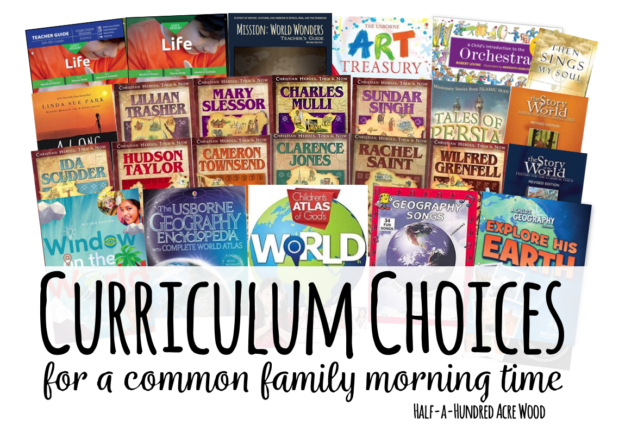
In addition to our morning time, we also enjoy a family read-aloud time in the evenings as we mentioned previously. The curriculum choices listed below for each grade level flesh out general history and science topics that relate to our morning time to provide us with as much of a cohesive, one-room schoolhouse atmosphere as possible. If you want to see what Mission World Wonders is like in action, see the lower part of this post that includes photos and details about science, art, and other activities.
Many of the resources below are part of the Compass Classroom Membership, a monthly subscription option allowing homeschool families access to over 30 products. You can test drive all the courses for free for two weeks!
High School (Grade 10)
- Bible (1 credit) – The Greenleaf Guide to Old Testament History (family discussion during morning time)
- World History (1 credit) – Dave Raymond’s Antiquity | Download 2 Free Lessons. This story-driven history curriculum follows an overarching theme of redemption throughout its history, provides a springboard for deep discussions with an upfront explanation of the Socratic method of asking questions (for both students and parents), and teaches and emphasizes how to take notes during lectures and how to build a portfolio that, at completion, may be used as a history textbook for younger children to read. Read our review of Dave Raymond’s American History which is similar in style and structure.
- Lab Science (1 credit) – Exploring Creation with Physical Science – 2nd Edition. We prefer the older edition of Exploring Creation with Physical Science.
- Foreign Language (1 credit) – Visual Latin II | Download 2 Free Lessons. You can read more about why we love Visual Latin here.
- Using this in conjunction with Lingua Latina and the Lingua Latina Companion
- English Composition (1 credit) – Creative Writing with Jonathan Rogers (Fall Semester for 1/2 credit – Click on sample lessons tab to view the first two lessons of each course – Writing through the Wardrobe, Writing with Hobbits, Writing with the Bog Owl, and Writing through To Kill a Mockingbird) and Rhetoric (1/2 credit) – Fitting Words (Spring Semester for 1/2 credit. The remainder of this course will be completed during his junior year. It is excellent. You can read about it here.)
- Math (1 credit) – Math U See Geometry (Although we loved Jacobs Geometry for our oldest, Math U See will be a better fit for our second son.)
- Visual Arts (1 credit) – Filmmaking from the First Directors. Our second son enjoys working in video and scripting, and this course will provide him with some structure on how to do it well.
- Literature Selections (mentioned above)
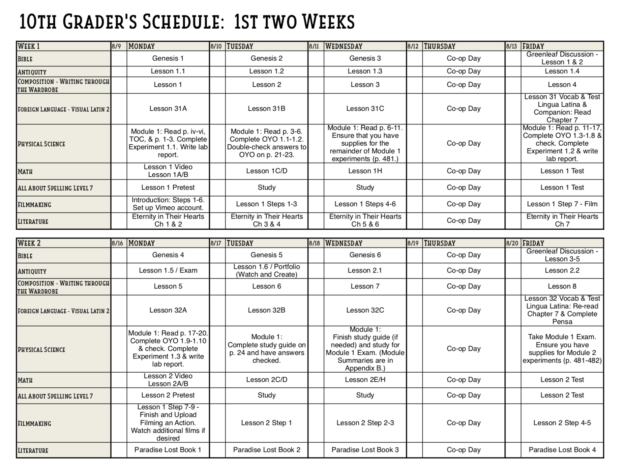
Middle School (Grade 7)
Our 7th grader’s science, geography, and history work are taken primarily from Mission: World Wonders. Other subjects we incorporate at this level are Latin, Logic, English Composition, and Math.
- World History – Story of the World Volume 1: Ancient Times (From the Earliest Nomads to the Last Roman Emperor) and Story of the World Volume 2: The Middle Ages (From the Fall of Rome to the Rise of the Renaissance) as assigned in Mission World Wonders. (He’ll also watch Dave Raymond’s Antiquity to participate in discussions with his older brother.)
- Bible – The Greenleaf Guide to Old Testament History (family discussion during morning time)
- Science – Mission World Wonders – God’s Design for Life (World of Plants) and God’s Design for Heaven & Earth (Our Planet Earth)
- Foreign Language – Visual Latin I | Download 2 Free Lessons. Our third son will complete Visual Latin during middle school before heading into Spanish in high school. (He has wanted to work in construction since age 2, so Spanish will be his high school level foreign language.)
- Using this in conjunction with Lingua Latina and the Lingua Latina Companion
- English Composition – IEW Structure & Style for Students Level B. We have used IEW for years, but this year I wanted to grant the opportunity for more independence. We are looking forward to this video program (taught by Andrew Pudewa – with students as the intended audience) which may be completed in 24 to 30 weeks and includes an assortment of source texts involving science and ancient literature. You can try three weeks free here.
- Math – Math U See Prealgebra. Most math programs implement either too few math problems or too many. This one seems to have a good balance, and it’s a math course our son is actually wanting to take. We’ll share more about our experience as the year progresses.
- Logic – Fallacy Detective (1st semester) and Art of Argument (2nd semester).
- Cartography/Geography – Tracing & grid-drawing according to our Mission: World Wonders plan. We will likely use Draw the World to assist with the effort in learning to draw the world freehand from memory and will also be incorporating these Memoria Press country capitals flashcards and select readings from the Memoria Press Geography I: Middle East, North Africa, and Europe Text and Geography II: Sub-Saharan Africa, Asia, Oceania, & the Americas Text
- Literature Selections are mentioned above
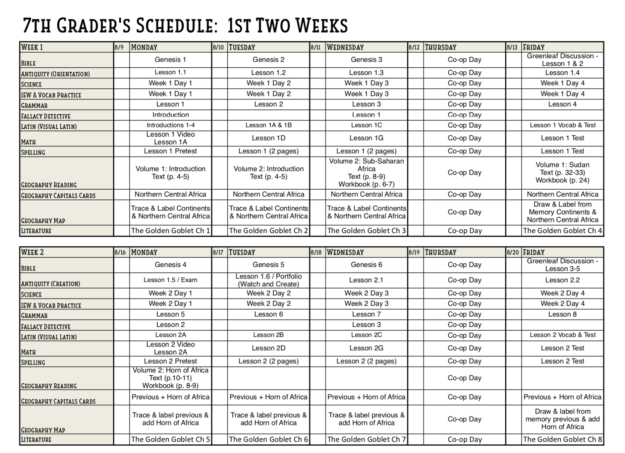
Elementary School (Grade 2)
- Family Morning Time/Mission World Wonders:
- World History (from Mission World Wonders). Story of the World Volume 1: Ancient Times (From the Earliest Nomads to the Last Roman Emperor)and Story of the World Volume 2: The Middle Ages (From the Fall of Rome to the Rise of the Renaissance) as assigned in Mission World Wonders – and select titles from our favorite ancient history picture books and favorite middle ages picture books
- Geography Memory Work (from Mission World Wonders).
- Science (from Mission World Wonders) – God’s Design Series: World of Plants, World of Animals, and Our Planet Earth as scheduled in our Mission World Wonders Curriculum Guide
- Bible: The Child’s Story Bible by Catherine Vos
- All About Reading Level 2. We LOVE All About Reading. (Click here for why.) He’s been re-reading all his Level 1 books this summer, and it’s such a relief that he loves it this much.
- All About Spelling Level 2
- Finish Script-n-Scribe Letter Connector (for the first 12 weeks) followed by either Truth Traveler or a new Script-n-Scribe book featuring fables or parables. Maybe?
- Math U See Beta. We swapped to Math U See last year and suddenly he started understanding place value. He loves this program, and I love that he loves math now. (We’ll be starting the year off with a review of Alpha before heading into Beta.)
- IEW Bible Heroes Writing Lessons (2nd semester, if he’s ready) – Includes free Teacher Edition ebook
- Literature selections (will write in which books we read each week from our favorite ancient history picture books and favorite middle ages picture books)
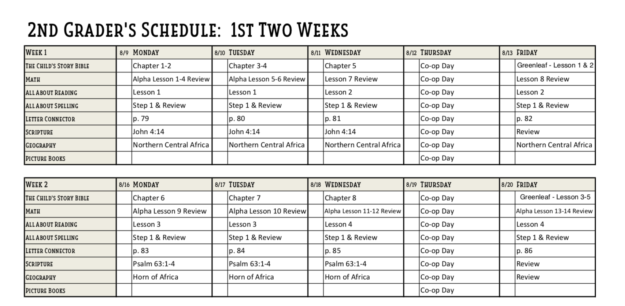
It’s important to note that we don’t become slaves to a curriculum but use the curriculum as a tool for learning. (You are master over the curriculum. Not the other way around.) With that in mind, our curriculum choices and schedules are subject to change if we find that a particular resource is not fulfilling its purpose.
And… although it’s not written into the schedule, hobbies, chores, and play are all a part of our normal everyday routine.
Sample Homeschool Schedules
I thought I’d wrap this up by including a sample schedule here for the sake of others who would like to see a schedule. Our actual schedule deviates from this quite a bit for our older children. The only thing that remains consistent for everyone is our family morning time. Our older students choose the order in which they complete assignments, so one may be working on math while another is working on Latin. When I’m working with a student on writing/editing (IEW), his brothers are working on something they can do without my assistance so that they don’t interrupt.
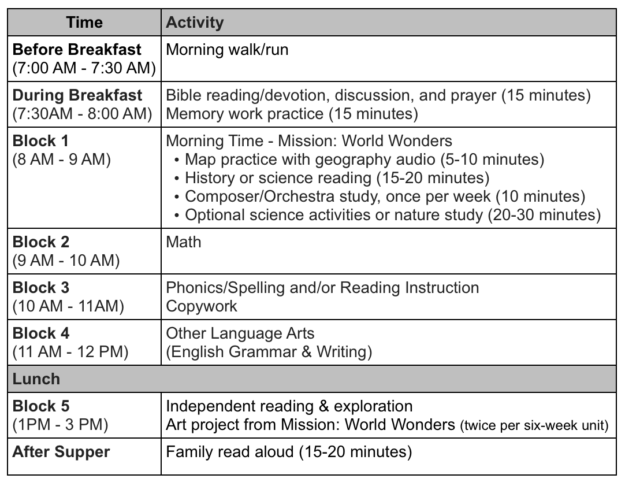
In a more simplistic format, here’s a rundown of what our core, bare-bones schedule sort of looks like (but Block 1 consists of our Mission World Wonders Morning Time instead of just Memory work and maps).

If you have any questions about this schedule, about any of our curriculum choices or literature selections, or about homeschool planning in general, feel free to give us a shout!
[I am] confident of this very thing, that he which has begun a good work in you will perform it until the day of Jesus Christ: -Philippians 1:6
This post was originally published in July 2021.


